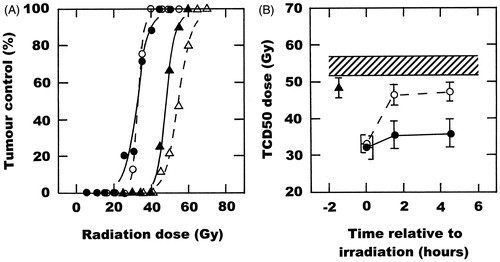Figures & data
Figure 1. The effect of OXi4503 (50 mg/kg) and mild temperature hyperthermia (41.5 °C, 60 min) on the radiation response of a C3H mammary carcinoma. (A) Radiation dose response curves for local tumour control in tumours treated with radiation alone (△), OXi4503 injected 1.5 h before irradiating (▴), radiation administered in the middle of heating (○), or the combination of OXi4503, radiation and heat (•). Points are for an average of 10 mice with the lines drawn following logit analysis. (B) The TCD50 doses are a function of time relative to irradiation, and are taken from the curves shown in (A) and for other similar dose–response curves. Results are for radiation alone (![]()

Figure 2. The effect of OXi4503 (50 mg/kg) and mild temperature hyperthermia (41.5 °C, 60 min) on the radiation response of normal foot skin. (A) Radiation dose response curves for moist desquamation in skin treated with radiation alone (△), OXi4503 injected 1.5 h before irradiating (▴), radiation administered in the middle of heating (○), or the combination of OXi4503, radiation and heat (•). Points are for an average of seven mice with the lines drawn following logit analysis. (B) The MDD50 doses are a function of time relative to irradiation, and are taken from the curves shown in (A) and for other similar dose–response curves. Results are for radiation alone (![]()


